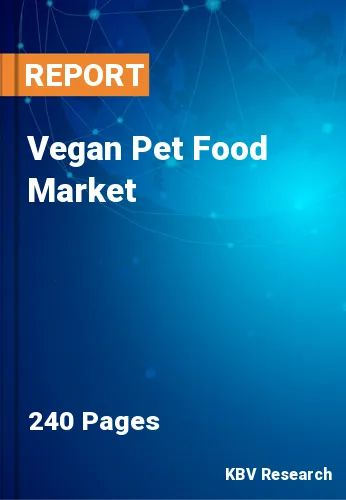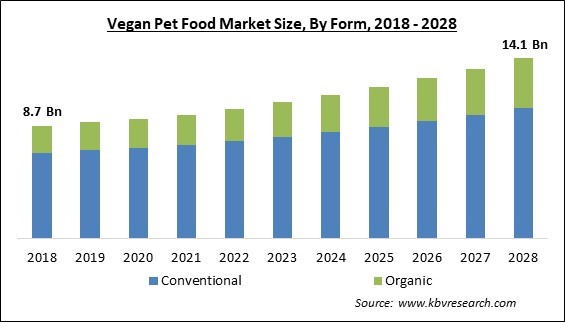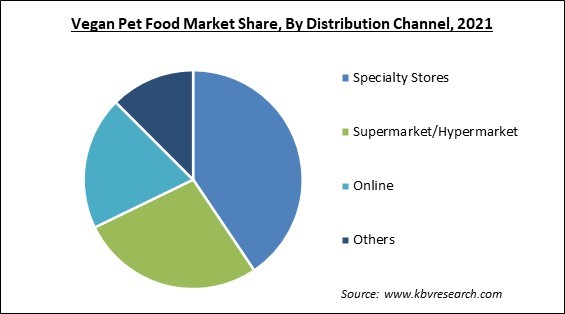
The Global Vegan Pet Food Market size is expected to reach $14.1 billion by 2028, rising at a market growth of 5.7% CAGR during the forecast period.
People care about their dogs and are willing to spend a lot of money to keep them healthy. Vegan pet owners choose to provide vegan food to their animals. Clean labeling, sustainability promises, and appropriate nutrition are always preferred by most pet owners. Pet owners are increasingly looking for labeling and packaging that reflect their specific feeding preferences and requirements. The majority of Europeans consider their pet to be a member of their family. Dogs and cats are the most popular pets among other animals, such as birds, rabbits, fish, and others, due to their friendly nature.
Dogs are renowned for their bravery and loyalty. Furthermore, some of the households have more than one dog. Additionally, the number of pet-friendly workplaces is rapidly expanding throughout the world. Many parents ask their children to look after their pets on their own. It gives them company and aids in the development of a sense of responsibility. Some young couples choose to begin their family by adopting a dog and raising it as if it were their child.
Pets have varied roles in each family since they are trained differently in different cultures. This increased humanization of pets raises awareness of the quality and ingredients of pet food provided by owners, resulting in a surge in demand for vegan pet food. People are also more worried about the slaughter of helpless animals and the environmental destruction caused by animal husbandry. Some people are devoted to their pets and recognize that animals, like humans, experience pain, hunger, love, joy, fear, thirst, and loneliness. As a result, they favor vegan diets for both themselves and their dogs, boosting the vegan pet food business.

The global vegan pet food sector is benefiting from the COVID-19 pandemic. During the pandemic, there was a spike in demand for vegan pet food among pet owners. This occurred because as people stayed at home, it resulted in a higher rate of pet adoption, which in turn increased demand for pet food and vegan pet food. Various sales channels, like hypermarkets/supermarkets and specialized stores, were shut down as a result of rigorous lockout policies, resulting in a modest decrease in the availability of vegan pet food. Numerous significant businesses, on the other hand, are shifting their sales channels to the internet, and they are working to boost the volume of pet food production.
Pet humanization has become a buzzword in the mainstream media around the world in recent years. The transition from pet ownership to pet parenting has been a significant and fundamental development in the pet food industry, particularly in developed nations. In prosperous countries, more than one-third of families have a pet. As a result, as pets become more humanized, the pet food business is predicted to rise. The growing relationship between pet owners and their pets’ influences consumers' willingness to spend more on pet food. The optimum health of their pets is becoming one of the topmost priorities of pet owners. They try to keep their pets healthy by giving them a proper nutrient-filled diet that is easy to digest.
The invention of vegan alternatives in pet the food market has arrived at an opportune moment as the vegan pet owners want their pets to adapt to this lifestyle along with them. This discovery has been critical for industry growth. Organic dog food has a number of health benefits for dogs, including fewer skin allergies and diseases, fewer digestive disorders, improved general health, and a higher quality of life. The global expansion of dog ownership is being driven by changing family structures and lifestyles that encourage pet adoption, resulting in increased demand for organic dog food. Vegan formulations are widely used to help dogs with digestive difficulties such as stomach upset, constipation, and bloating.
According to the Federal Food, Drug, and Cosmetic Act of 1938, animal food must be safe to eat and produced in sanitary conditions (FFDCA). There must be no harmful components in the foods, and they must be labeled as correctly as possible. The Food Safety Modernization Act of 2010 (FSMA) set certification, sterilization, cleanliness, and ingredient labeling requirements for pet food manufacturers in the United States. In contrast to the Asia Pacific and South American areas, the animal feed industry is subject to stringent government regulations. When it comes to pet food ingredients, preservatives, ethoxyquin, and food colorings are all controlled differently in different countries.

Based on Form, the market is segmented into Conventional and Organic. The organic segment garnered a substantial revenue share in the vegan pet food market in 2021. As people are becoming more aware about harmful effects of pesticides and artificial fertilizers on the planet as well as the human health, they are attempting to move to organic food. This holds true for the vegan pet food market as well. Pet owners want their pet to only eat healthy organic vegan pet food made from organically grown products.
Based on Pet Food Type, the market is segmented into Dry, Wet, Treats & Snacks, and Others. The dry pet food segment acquired the largest revenue share in the vegan pet food market in 2021. Dry pet food is the most popular and fastest-growing type of pet food. Furthermore, the dry pet food market is in high demand due to the convenience it provides to pet owners. Dry food minimizes tartar and plaque development on dogs' teeth, allowing them to maintain proper dental hygiene. In addition, this product category delivers the crunch and chewing that animals require to stay healthy. Dry food does not need to be frozen as much as canned food.
Based on Pet Type, the market is segmented into Dogs, Cats, and Others. The cat segment witnessed a substantial revenue share in the vegan pet food market in 2021. Cats require a lot of sulfuric amino acids like methionine, as well as taurine, an amino sulfone. Companies have increased their investments to meet the special needs of cats as a result of their distinct needs. The practice of owning numerous cats is gaining popularity around the world, propelling the industry forward. Cats, on the other hand, require less training and can spend more time alone than dogs.
Based on Distribution Channel, the market is segmented into Specialty Stores, Supermarket/Hypermarket, Online, and Others. The online segment observed a substantial revenue share in the vegan pet food market in 2021. Due to the global development of internet penetration and smartphones, which accelerates demand for vegan pet food, the online sales channel is the fastest expanding segment by distribution channel. However, because of the increased consumption of vegan pet food, the specialty stores segment is likely to remain the market's largest and most dominant segment. The widespread availability of pet food through a number of outlets, ranging from modern trade to online sales channels, has aided industry expansion. Furthermore, the availability of pet food on e-commerce platforms has allowed people to purchase goods without having to leave their homes. E-commerce not only offers convenience and comfort, but also allows purchasers to do in-depth product research, compare pricing and benefits, and evaluate total value before making a purchase.
| Report Attribute | Details |
|---|---|
| Market size value in 2021 | USD 9.6 Billion |
| Market size forecast in 2028 | USD 14.1 Billion |
| Base Year | 2021 |
| Historical Period | 2018 to 2020 |
| Forecast Period | 2022 to 2028 |
| Revenue Growth Rate | CAGR of 5.7% from 2022 to 2028 |
| Number of Pages | 240 |
| Number of Tables | 449 |
| Report coverage | Market Trends, Revenue Estimation and Forecast, Segmentation Analysis, Regional and Country Breakdown, Companies Strategic Developments, Company Profiling |
| Segments covered | Form, Pet Food Type, Pet Type, Distribution Channel, Region |
| Country scope | US, Canada, Mexico, Germany, UK, France, Russia, Spain, Italy, China, Japan, India, South Korea, Singapore, Malaysia, Brazil, Argentina, UAE, Saudi Arabia, South Africa, Nigeria |
| Growth Drivers |
|
| Restraints |
|
Based on Regions, the market is segmented into North America, Europe, Asia Pacific, and Latin America, Middle East & Africa. North America acquired the largest revenue share in the vegan pet food market in 2021. This is due to the high rate of pet adoption in American households. Customers in North America have a positive attitude toward pet humanization, and it is widely accepted, which will help the regional market grow even more. Besides, the popularity of veganism is also on the rise in the United States and Canada, major countries in the region.
Free Valuable Insights: Global Vegan Pet Food Market size to reach USD 14.1 Billion by 2028
The market research report covers the analysis of key stake holders of the market. Key companies profiled in the report include The Colgate-Palmolive Company, Mars, Inc. (API Fish Care), Nestle S.A., United Natural Foods, Inc. (Wild Harvest), V-Dog, Inc., The Pack Pet Limited, Supreme Pet Foods Ltd., Freshpet, Inc., and Evolution Diet Pet Food Co.
By Form
By Pet Food Type
By Pet Type
By Distribution Channel
By Geography
The vegan pet food market size is projected to reach USD 14.1 billion by 2028.
Increasing acceptance of vegan food products are increasing are driving the market in coming years, however, lack of uniformity in regulations limits international trade growth of the market.
The Colgate-Palmolive Company, Mars, Inc. (API Fish Care), Nestle S.A., United Natural Foods, Inc. (Wild Harvest), V-Dog, Inc., The Pack Pet Limited, Supreme Pet Foods Ltd., Freshpet, Inc., and Evolution Diet Pet Food Co.
The expected CAGR of the vegan pet food market is 5.7% from 2022 to 2028.
The Conventional segment acquired the maximum revenue share in the Global Vegan Pet Food Market by Form in 2021, thereby, achieving a market value of $10.1 billion by 2028.
The North America is the fastest growing region in the Global Vegan Pet Food Market by Region in 2021, and would continue to be a dominant market till 2028.
Our team of dedicated experts can provide you with attractive expansion opportunities for your business.
